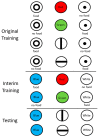Comparative Cognition Research Demonstrates the Similarity between Humans and Other Animals
- PMID: 37048420
- PMCID: PMC10093641
- DOI: 10.3390/ani13071165
Comparative Cognition Research Demonstrates the Similarity between Humans and Other Animals
Abstract
The field of comparative cognition represents the interface between the cognitive behavior of humans and other animals. In some cases, research demonstrates that other animals are capable of showing similar cognitive processes. In other cases, when animals show behavior thought to be culturally determined in humans, it suggests that simpler processes may be involved. This review examines research primarily with pigeons (out of convenience because of their visual ability). I start with the concept of sameness and follow with the concept of stimulus equivalence, the building blocks of human language. This is followed by research on directed forgetting, the cognitive ability to maintain or forget information. A hallmark of cognition is transitive inference performance (if A < B, and B < C, the understanding that A < C), but the variety of species that show this ability suggests that there may be simpler accounts of this behavior. Similarly, experiments that demonstrate a form of cognitive dissonance in animals suggest that dissonance may not be necessary to explain this biased behavior. Furthermore, examples of sunk cost in pigeons suggests that the human need to continue working on a failing project may also have a biological basis. Finally, pigeons show a preference for a suboptimal choice that is similar to unskilled human gambling, a finding that may clarify why humans are so prone to engage in this typically losing activity.
Keywords: comparative cognition; equivalence; gambling; justification of effort; sameness; transitive inference.
Conflict of interest statement
The author declares no conflict of interest.
Figures










Similar articles
-
Within-trial contrast or Wagner's SOP model: Can they both account for two presumed complex cognitive phenomena?J Exp Psychol Anim Learn Cogn. 2020 Jul;46(3):235-242. doi: 10.1037/xan0000238. J Exp Psychol Anim Learn Cogn. 2020. PMID: 32730081
-
Does cognition differ across species, and how do we know? Lessons from research in transitive inference.J Exp Psychol Anim Learn Cogn. 2021 Jul;47(3):223-233. doi: 10.1037/xan0000301. J Exp Psychol Anim Learn Cogn. 2021. PMID: 34618524
-
Resolving the paradox of suboptimal choice.J Exp Psychol Anim Learn Cogn. 2016 Jan;42(1):1-14. doi: 10.1037/xan0000085. Epub 2015 Dec 7. J Exp Psychol Anim Learn Cogn. 2016. PMID: 26640967 Review.
-
How does cognitive dissonance influence the sunk cost effect?Psychol Res Behav Manag. 2018 Mar 1;11:37-45. doi: 10.2147/PRBM.S150494. eCollection 2018. Psychol Res Behav Manag. 2018. PMID: 29535561 Free PMC article.
-
[Advances in the experimental analysis of behavior: issues of choice behavior, comparative cognition, and human language].Shinrigaku Kenkyu. 1994 Dec;65(5):395-411. doi: 10.4992/jjpsy.65.395. Shinrigaku Kenkyu. 1994. PMID: 7884978 Review. Japanese.
Cited by
-
Behavioural Methods to Study Cognitive Capacities of Animals.Animals (Basel). 2023 Nov 8;13(22):3445. doi: 10.3390/ani13223445. Animals (Basel). 2023. PMID: 38003062 Free PMC article.
-
Visual Discrimination Task in Guppies Using a Simultaneous Matching-to-Sample Procedure.Animals (Basel). 2025 Jul 1;15(13):1936. doi: 10.3390/ani15131936. Animals (Basel). 2025. PMID: 40646836 Free PMC article.
References
-
- Thorndike E.L. The Fundamentals of Learning. Teachers College Columbia University; New York, NY, USA: 1932.
-
- Skinner B.F. The Behavior of Organisms: An Experimental Analysis. Appleton-Century-Crofts; New York, NY, USA: 1938.
-
- Pavlov I.P. Conditioned Reflexes. Oxford University Press; London, UK: 1927.
-
- Baillargeon R. Object permanence in 3½- and 4½-month-old infants. Devel. Psychol. 1987;23:655–664. doi: 10.1037/0012-1649.23.5.655. - DOI
Publication types
LinkOut - more resources
Full Text Sources

